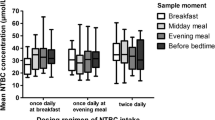Abstract
Introduction
In most countries, hereditary tyrosinemia type 1 is not included in routine newborn screening.
Discussion
We present the case of a female newborn with prenatal diagnosis of hereditary tyrosinemia type 1 and clear identification of this disorder by succinylacetone measurement in cord blood and peripheral blood immediately after birth. Succinylacetone was 44 μmol/L (norm <5 μmol/L) and increased within 12 h to 87.5 μmol/L.
Conclusion
With the high toxic potential of downstream metabolites, these data clearly point out the necessity of early nitisinone treatment to prevent symptomatic disease.



Similar content being viewed by others
References
Al-Dirbashi OY, Rashed MS, Jacob M et al (2008) Improved method to determine succinylacetone in dried blood spots for diagnosis of tyrosinemia type 1 using UPLC-MS/MS. Biomed Chromatogr 22:1181–1185
Allard P, Grenier A, Korson MS, Zytkovicz TH (2004) Newborn screening for hepatorenal tyrosinemia by tandem mass spectrometry: analysis of succinylacetone extracted from dried blood spots. Clin Biochem 37:1010–1015
Alvarez F et al (2005) Nitisinone (NTBC) treatment of hepatorenal tyrosinemia in Quebec. J Inherit Metab Dis 28(Suppl 1):49
Grompe M (2001) The pathophysiology and treatment of hereditary tyrosinemia type 1. Semin Liver Dis 21:563–571
Holme E, Lindstedt S (1998) Tyrosinaemia type I and NTBC (2-(2-nitro-4- trifluoromethylbenzoyl)-1, 3-cyclohexanedione). J Inherit Metab Dis 21:507–517
Holme E, Lindstedt S (2000) Nontransplant treatment of tyrosinemia. Clin Liver Dis 4:805–814
Hostetter MK, Levy HL, Winter HS, Knight GJ, Haddow JE (1983) Evidence for liver disease preceding amino acid abnormalities in hereditary tyrosinemia. N Engl J Med 308:1265–1267
Koelink CJ, van Hasselt P, van der Ploeg A et al (2006) Tyrosinemia type I treated by NTBC: how does AFP predict liver cancer? Mol Genet Metab 89(4):310–315
la Marca G, Malvagia S, Zammarchi E et al (2008) The inclusion of succinylacetone as marker for tyrosinemia type I in expanded newborn screening programs. Rapid Commun Mass Spectrom 22:812–818
Lindblad B, Lindstedt S, Steen G (1974) On the enzymatic defects in hereditary tyrosinemia. Proc Natl Acad Sci 74:4641–4645
Lindstedt S, Holme E, Lock EA, Hjalmarson O et al (1992) Treatment of hereditary tyrosinaemia type I by inhibition of 4-hydroxyphenylpyruvate dioxygenase. Lancet 340:813–817
Magera MJ, Gunawardena N, Matern D et al (2006) Quantitative determination of succinylacetone in dried blood spots for newborn screening of tyrosinemia type I. Mol Genet Metab 88:16–21
Mitchell G, Grompe M, Lambert M, Tanguay R (2001) Hypertyrosinemia. In: Scriver CR, Beaudet AL, Sly WS, Valle D (eds) The metabolic and molecular bases of inherited disease, 8th edn. McGraw-Hill, New York, pp 1777–1806
Rashed MS, Al-Ahaidib LY, Al-Dirbashi OY et al (2005) Tandem mass spectrometric assay of succinylacetone in urine for the diagnosis of hepatorenal tyrosinemia. Anal Biochem 339:310–317
Russo P, Mitchell G, Tanguay R (2001) Tyrosinemia: a review. Pediatr Dev Pathol 4:212–221
Sander J, Janzen N, Peter M et al (2006) Newborn screening for hepatorenal tyrosinemia: tandem mass spectrometric quantification of succinylacetone. Clin Chem 52:482–487
Santra S, Baumann U (2008) Experience of nitisinone for the pharmacological treatment of hereditary tyrosinaemia type 1. Expert Opin Pharmacother. 9:1229–1236
Schulze A, Frommhold D, Hoffmann GF, Mayatepek E (2001) Spectrophotometric microassay for delta-aminolevulinate dehydratase in dried-blood spots as confirmation for hereditary tyrosinemia type I. Clin Chem 47:1424–1429
Scott CR (2006) The genetic tyrosinemias. Am J Med Genet Part C Semin Med Genet 142C:121–126
Tarini BA (2007) The current revolution in newborn screening: new technology, old controversies. Arch Pediatr Adolesc Med 161:767–772
Turgeon C, Magera MJ, Allard P et al (2008) Combined newborn screening for succinylacetone, amino acids, and acylcarnitines in dried blood spots. Clin Chem 54:657–664
Wästfeld M, Fadeel B, Henter JI (2006) A journey of hope: lessons learned from studies on rare diseases and orphan drugs. J Intern Med 260:1–10
Weigel JF, Janzen N, Pfäffle RW et al (2007) Tandem mass spectrometric determination of succinylacetone in dried blood spots enables presymptomatic detection in a case of hepatorenal tyrosinaemia. J Inherit Metab Dis 30:610
Wilson JM, Jungner G (1968) Principles and practice of screening for disease. WHO, Geneva, p 343
Author information
Authors and Affiliations
Corresponding author
Rights and permissions
About this article
Cite this article
Schlump, JU., Mayatepek, E. & Spiekerkoetter, U. Significant increase of succinylacetone within the first 12 h of life in hereditary tyrosinemia type 1. Eur J Pediatr 169, 569–572 (2010). https://doi.org/10.1007/s00431-009-1074-1
Received:
Accepted:
Published:
Issue Date:
DOI: https://doi.org/10.1007/s00431-009-1074-1



